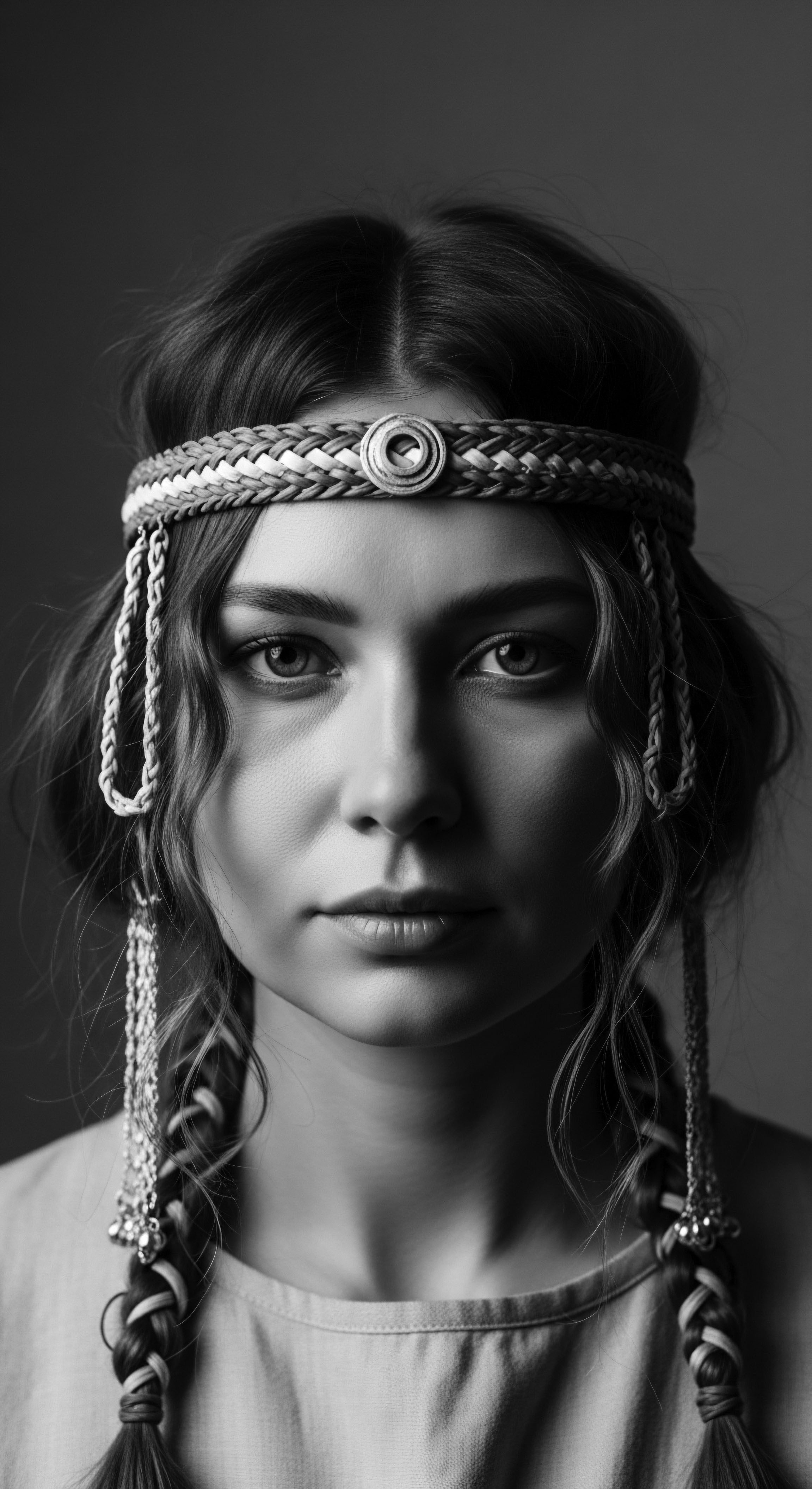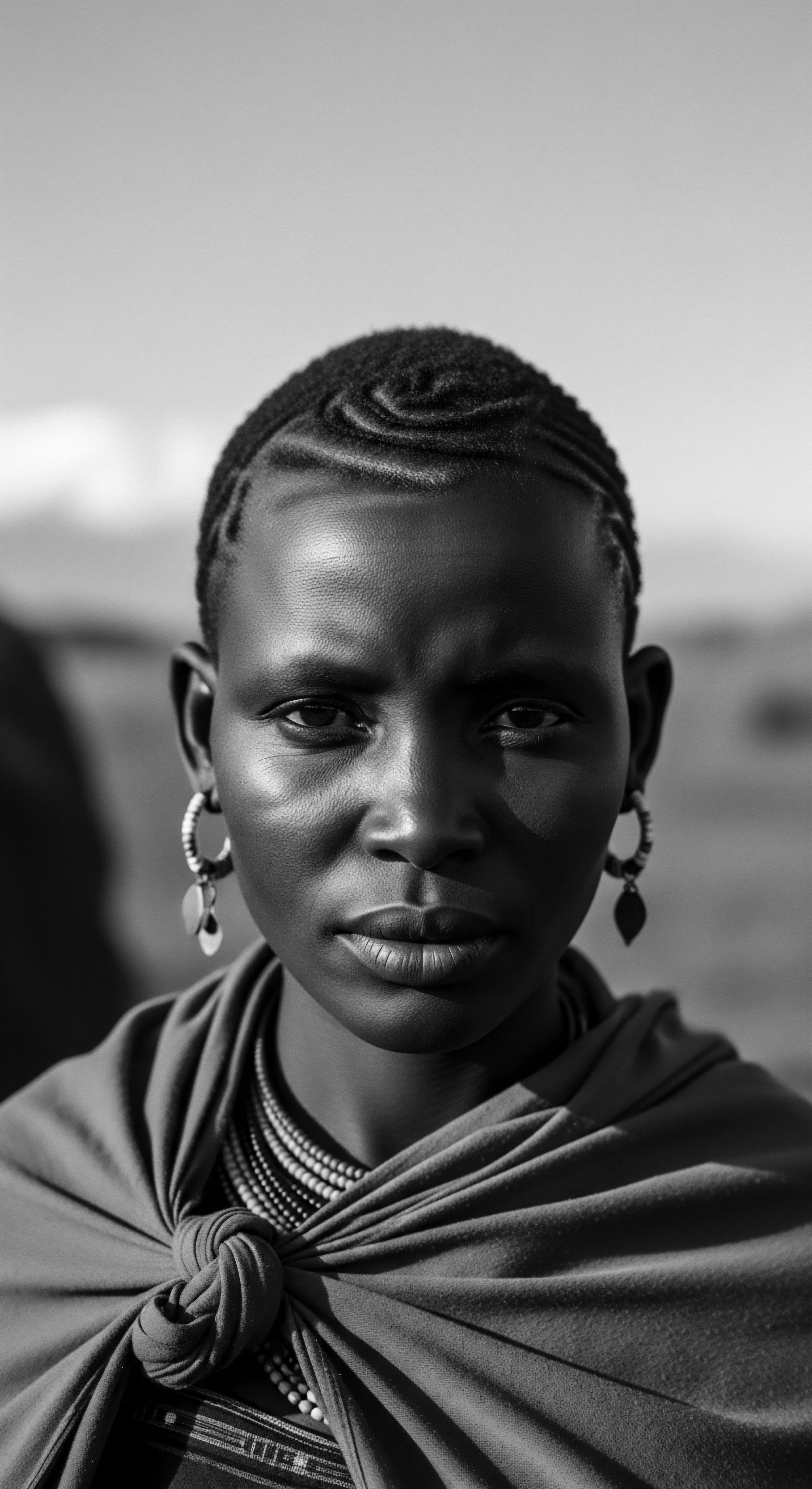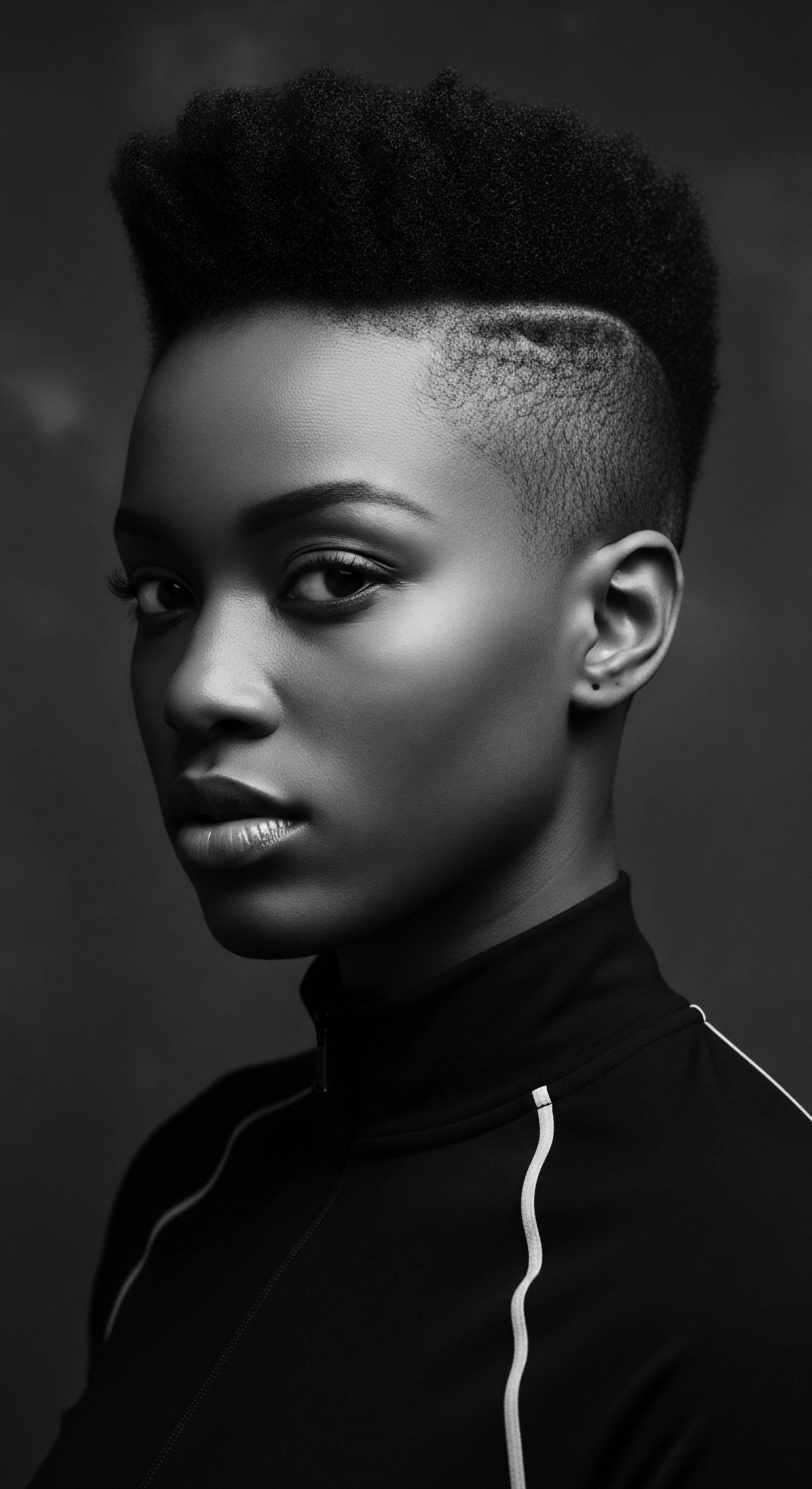
Roots
Consider for a moment the very helix of a single strand, born not just from follicular cells, but from countless generations of ancestral wisdom, carried through the ages. It is a memory, a living archive. When we contemplate the question of how historical beauty standards have shaped the journey of textured hair dryness, we are, in a profound sense, tracing the very lineage of a people, understanding their relationship with their innate physical being.
This is no mere academic exercise; it is an intimate exploration of resilience, adaptation, and the enduring spirit of Black and mixed-race communities. Our task is to listen to the whispers of the past, to hear how the very fiber of our hair has responded to the currents of time, the pressures of perception, and the deep, abiding yearning for self-acceptance.
The unique architecture of textured hair, often characterized by its elliptical follicle shape and varied curl patterns – from loose waves to tight coils – dictates an inherent predisposition toward dryness. Each bend and curve along the hair shaft acts as a tiny impediment to the natural oils, the sebum, produced by the scalp. This sebum struggles to descend the winding path to moisturize the entire length of the strand, leaving the ends particularly vulnerable.
This biological reality, a gift of genetic diversity, has always necessitated particular methods of care, methods often passed down through families and communities, forming the bedrock of our textured hair heritage . Our ancestors, living in climates both arid and humid, intuitively understood this need for external fortification, for protective practices that honored the hair’s very nature.
Before the advent of widespread scientific nomenclature, traditional societies developed their own ways of understanding hair. These understandings were not rooted in microscopes but in generations of observation and practice. They recognized the need for sustenance for the hair, using readily available natural resources.
While modern classifications, such as those based on curl type, offer a scientific framework, they sometimes overshadow the deeper, more holistic perspectives of historical care. These traditional lexicons were often tied to the hair’s health, its luster, and its ability to hold styles, implicitly recognizing dryness as a state to be remedied.
The intrinsic structure of textured hair inherently leans towards dryness, a biological truth acknowledged and addressed through centuries of ancestral wisdom.
Hair growth cycles, influenced by nutrition, environment, and overall wellness, were also implicitly understood in ancestral contexts. A well-nourished body, sustained by traditional diets rich in vital nutrients, supported stronger hair. Droughts or periods of scarcity would impact hair’s vibrancy, a connection deeply felt and acted upon through adaptive practices.
The historical environment, whether the humid warmth of West Africa or the diverse climates of the diaspora, shaped the ingredients and techniques employed. For instance, the prevalence of shea trees in certain regions led to the widespread use of shea butter as a multi-purpose emollient, not only for skin but vitally for hair, providing a protective barrier against moisture loss in dry conditions.
Let us reflect on the very first whispers of care for textured hair. In ancient African societies, hair was more than just fiber; it was a profound symbol of status, identity, age, and spiritual connection. The very acts of cleansing, oiling, and styling were communal, sacred rituals. These practices, intrinsically linked to the hair’s health, naturally addressed its propensity for dryness.
For example, the use of red palm oil and kola nut extract in West African communities, or argan oil among Berber women, were not merely cosmetic applications. They were deliberate, often medicinal, acts designed to seal moisture, protect from environmental stressors, and ensure the hair’s continued vitality. These were not simply beauty routines; they were integral components of well-being, deeply embedded in a community’s rhythm, a testament to enduring ancestral practices .

Ritual
The journey of textured hair through the ages is a compelling story of human ingenuity, artistic expression, and profound adaptation. When we examine how historical beauty standards have intersected with the reality of textured hair dryness, we observe a telling evolution in styling techniques, the tools crafted for care, and the very transformations sought. Ancestral practices for styling were often rooted in the pragmatic need for hair preservation, intrinsically countering dryness while simultaneously communicating cultural narratives.
Long before the modern term “protective styling” entered our vocabulary, communities across the African continent perfected techniques that shielded the hair from the elements, minimized manipulation, and locked in moisture. Intricate braids , elaborate cornrows , and various forms of locs were not simply aesthetic choices; they were intelligent responses to the hair’s natural inclination towards dryness and breakage. These styles would keep the hair contained, prevent tangling, and allow applied oils and butters to penetrate and remain on the strands for longer periods. The very act of sectioning and twisting hair created a protective environment, a sanctuary for each strand.
| Historical Practice Oiling Scalp and Strands with Indigenous Oils |
| Underlying Principle Addressing Dryness Sealing moisture, providing nutrients, soothing scalp. |
| Modern Parallel or Understanding Use of leave-in conditioners, hair milks, and natural oils (jojoba, argan, coconut) for moisture retention. |
| Historical Practice Intricate Braiding and Coiling |
| Underlying Principle Addressing Dryness Minimizing manipulation, protecting ends, retaining length. |
| Modern Parallel or Understanding "Protective styles" like box braids, twists, or flat twists to guard against environmental damage. |
| Historical Practice Mud Masks and Clay Treatments |
| Underlying Principle Addressing Dryness Cleansing gently, drawing impurities, providing minerals. |
| Modern Parallel or Understanding Bentonite clay masks or rhassoul clay treatments for clarifying without stripping natural oils. |
| Historical Practice Hair Adornments and Covers (e.g. Headwraps) |
| Underlying Principle Addressing Dryness Physical protection from sun and dust, cultural expression. |
| Modern Parallel or Understanding Satin bonnets, silk scarves, or wide-brimmed hats to protect hair overnight or outdoors. |
| Historical Practice These parallels highlight the enduring wisdom of ancestral practices in mitigating textured hair dryness across generations. |
How did external beauty ideals begin to shift this deep-rooted understanding of hair care? With the advent of colonialism and the transatlantic slave trade, a stark contrast emerged. European beauty standards, valuing long, straight, fine hair, were imposed upon Black communities.
This imposition did not just change aesthetic preferences; it often demanded a radical alteration of the hair’s natural state, creating a direct conflict with its inherent need for moisture. The drive for straightness, often achieved through damaging methods, intensified the battle against dryness, making it a chronic condition for many.
Colonial beauty ideals, prioritizing straightness, often led to abandonment of traditional protective practices, exacerbating textured hair dryness.
The invention of the hot comb in the late 19th and early 20th centuries, and later, chemical relaxers, marked a pivotal moment. These tools and chemicals offered the promise of achieving the coveted straight aesthetic. Yet, this promise came at a profound cost to hair health. The high heat from hot combs could scorch the hair, stripping its natural moisture and making it brittle.
Chemical relaxers, particularly the lye-based formulas that were prevalent from the early 20th century, involved harsh alkaline chemicals designed to permanently alter the hair’s disulfide bonds. These processes, while effective in straightening, often led to severe scalp burns, significant hair breakage, and, crucially, chronic dryness due to the degradation of the hair’s natural lipid barrier and the loss of internal moisture (Byrd & Tharps, 2014). The very pursuit of a perceived beauty standard actively worked against the hair’s intrinsic need for moisture, creating a vicious cycle of damage and dryness that continues to impact collective memory and hair care choices today. This era saw a profound disjuncture between hair care and hair health, driven by an external gaze.

Ancestral Tools and Modern Echoes
The traditional toolkit for textured hair was diverse and often ingenious. Combs carved from wood or bone, simple picks, and various fibers for braiding were common. These tools were designed to work with the hair’s texture, minimizing pulling and breakage, and facilitating the application of nourishing substances. The focus was on detangling with care, a gentle process that preserved the hair’s moisture and structural integrity.
- Wooden Combs ❉ Crafted for wide teeth, allowing gentle detangling of coiled hair, reducing breakage that could expose the inner cortex and lead to moisture loss.
- Fibers for Braiding ❉ Often natural fibers were used as extensions in traditional styles, contributing to protective wraps and adding volume without harsh synthetic components.
- Earthenware Bowls ❉ Used for mixing natural ingredients like clays, oils, and herbs for conditioning treatments, ensuring the purity of ancestral concoctions.
In contrast, the tools adopted under the influence of Eurocentric standards – particularly the metal hot comb – brought an entirely different methodology. This tool, designed to apply intense heat, represented a radical departure from traditional, low-manipulation approaches. Its use necessitated repeated application of heat, which, over time, directly contributed to the hair’s inability to retain moisture. This persistent heat damage fractured the hair’s outer cuticle, allowing moisture to escape readily, thereby exacerbating the challenge of dryness.

Relay
The journey of textured hair care, from ancient practices to contemporary routines, represents a continuous dialogue between inherited wisdom and evolving understanding. How does the persistent challenge of textured hair dryness inform our holistic care and problem-solving, particularly when viewed through the lens of heritage and ancestral knowledge? It is a call to revisit the profound traditions that long understood the hair’s unique thirst, and to integrate those timeless insights with modern scientific understanding.
Building a personalized textured hair regimen today means drawing from a deep well. It is about understanding that the seemingly modern challenges of dryness, breakage, and scalp irritation have echoes in historical experiences. Ancestral practices offer more than just nostalgia; they provide a blueprint for a holistic approach to hair health that recognized the interconnectedness of diet, environment, and physical care. For instance, the emphasis on nutrient-dense foods in traditional African diets (such as root vegetables, leafy greens, and various forms of protein) indirectly contributed to hair strength and vitality, thereby improving its ability to retain moisture from within.

Nighttime Sanctuary and Bonnet Wisdom
The practice of protecting hair at night is not a recent innovation; it is a profound testament to ancestral ingenuity aimed at preserving moisture and preventing tangling. Long before satin bonnets became commonplace, various forms of head coverings, often made from natural fibers like cotton, were utilized. These coverings served a dual purpose ❉ they kept hair neatly contained, preventing the friction against coarse sleeping surfaces that could strip moisture and cause breakage, and they maintained the integrity of intricate daytime styles, thus extending their protective benefits. This practice, often seen as a simple routine, holds deep historical significance, reflecting a continuous effort to maintain hair health against the challenges of daily life and to preserve its natural oils .
The modern satin bonnet, therefore, is a direct descendant of this ancestral wisdom. Its smooth surface significantly reduces friction, which can otherwise roughen the hair’s cuticle, leading to moisture loss and increased dryness. This continuous effort to create a “nighttime sanctuary” speaks to a collective understanding, passed down through generations, that consistent protection is vital for maintaining the hair’s delicate moisture balance. The silk and satin fabrics preferred today are simply modern interpretations of the ancient recognition of the need for gentle, non-absorbent materials against the hair.

Ingredients That Speak Through Time
The search for effective moisturizers and conditioners for textured hair often leads back to the very ingredients that have been revered for centuries in African and diasporic communities. These were not random choices; they were selected for their profound ability to nourish, protect, and restore moisture.
- Shea Butter (Vitellaria Paradoxa) ❉ A staple from West Africa, revered for its emollient properties. Rich in fatty acids and vitamins, it forms a protective barrier on the hair shaft, sealing in moisture and guarding against dryness. Its historical use is widespread for both skin and hair.
- Coconut Oil (Cocos Nucifera) ❉ Widely used in Caribbean and coastal African communities, this oil is known for its ability to penetrate the hair shaft, reducing protein loss and helping to retain internal moisture, thereby combating dryness from within.
- Aloe Vera (Aloe Barbadensis Miller) ❉ Native to Africa and used widely across various indigenous cultures, its gel is a powerful humectant, drawing moisture from the air into the hair and providing soothing properties for the scalp.
- Castor Oil (Ricinus Communis) ❉ Particularly the dark, unrefined Jamaican Black Castor Oil, used extensively in Caribbean communities. It is a thick, viscous oil that offers strong sealing properties, beneficial for scalp health and locking in moisture for dry, brittle strands.
How do we bridge the knowledge of historical beauty standards, which sometimes exacerbated dryness, with these ancestral solutions? It involves a critical examination of the choices made under duress or external influence. For example, when chemical relaxers became popular, the widespread use of traditional, nourishing oils often diminished, leading to more prevalent dryness and damage.
The hair, stripped of its natural protectors and subjected to harsh chemicals, struggled to maintain its integrity. The problem-solving for textured hair today involves re-centering these time-honored ingredients, understanding their scientific properties, and applying them in ways that honor the hair’s natural state, rather than attempting to force it into an unnatural form.
Holistic hair health today benefits from a conscious return to ancestral ingredients and protective rituals, re-establishing balance against historical impositions.
The connection between overall well-being and hair health is not a new concept; it is an echo from ancient wellness philosophies. Stress, diet, and even spiritual harmony were understood to influence one’s physical presentation, including hair. For many Indigenous African cultures, hair was a direct conduit to spiritual realms and a reflection of inner balance. Therefore, maintaining healthy, moisturized hair was part of a larger commitment to holistic vitality.
The historical shift towards chemical processes often detached hair care from this deeper wellness framework, treating it as a superficial aesthetic adjustment rather than an integral part of one’s overall health. Reclaiming this perspective allows us to address dryness not merely as a cosmetic issue, but as a symptom of potential imbalance, inviting a return to practices that nourish the entire being.

Reflection
The story of textured hair, particularly its relationship with dryness as shaped by the currents of historical beauty standards, is a powerful testament to the enduring spirit of a heritage. Each strand, in its coiled wonder, holds within it the whispers of journeys taken, challenges faced, and triumphs celebrated. We have traced how the inherent thirst of textured hair was once understood and honored through ancestral rituals, a deep intuitive knowledge passed down across generations. These were not mere routines; they were acts of reverence, recognizing the hair as a vital part of identity and spirit.
Yet, the imposition of external beauty ideals, often alien to the natural expression of textured hair, introduced a profound disruption. The pursuit of straightness, through tools and chemicals that stripped the hair of its life force, created a pervasive narrative of dryness and damage. This was a direct consequence of a beauty standard that disregarded the hair’s fundamental biology and its cultural significance. The journey through these historical currents reveals that the struggle against dryness was, and in some ways remains, a struggle for self-acceptance, for the right to embody one’s authentic self without compromise.
Today, as we stand at the crossroads of ancient wisdom and contemporary understanding, the answer to textured hair dryness is not a simple product application. It is a profound meditation on reconnection. It is about understanding that the solutions lie not in erasing texture, but in celebrating it; not in fighting its nature, but in nurturing it. The legacy of resilience, the deep intelligence of ancestral care, and the burgeoning scientific validation of these practices converge to offer a path forward.
To care for textured hair is to honor a lineage, to draw from the wellspring of inherited knowledge, and to consciously choose practices that restore balance, moisture, and vitality. It is a continuous act of affirmation, recognizing that the beauty of a strand, indeed the soul of a strand, thrives in its nourished, unbound state, echoing the wisdom of generations past and inspiring those yet to come.

References
- Byrd, A. D. & Tharps, L. L. (2014). Hair Story ❉ Untangling the Roots of Black Hair in America. St. Martin’s Griffin.
- Gordon, E. (2018). The Black Hair Handbook ❉ A Treasury of Culture, History, and Hair Care. New Voices.
- Hooks, B. (1992). Black Looks ❉ Race and Representation. South End Press.
- Patton, T. O. (2006). Hot Comb. Pantheon.
- Tharps, L. L. (2022). The World According to Fannie Davis ❉ My Mother’s Life in the Detroit Numbers. Grand Central Publishing.
- Walker, A. (1979). In Search of Our Mothers’ Gardens ❉ Womanist Prose. Harcourt Brace Jovanovich.
- Mercer, K. (1994). Welcome to the Jungle ❉ New Positions in Cultural Politics. Routledge.
- Banks, I. (2000). Hair Matters ❉ Beauty, Power, and Black Women’s Consciousness. New York University Press.
